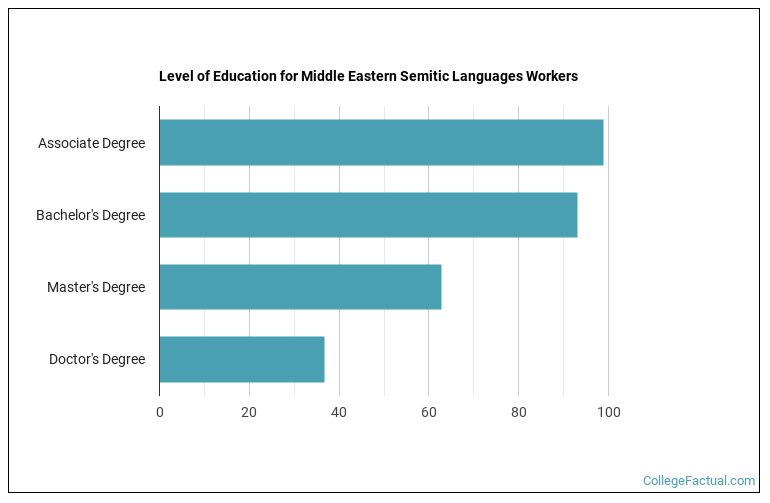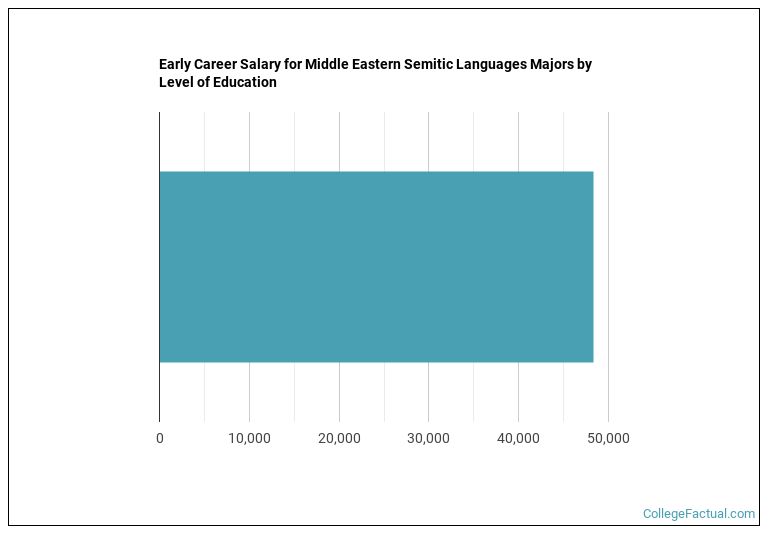 by our College Data Analytics Team
by our College Data Analytics TeamMiddle Eastern Semitic Languages are known to have the longest written lifespan of any language, dating back to the B.C era. A major in Middle Eastern Semitic Languages focuses on one or more Middle/Near Eastern Language of the ancient and modern region of Middle/Near East, Western Asia, Europe, and North Africa. Students will study language as well as philology, culture, history and business applications behind the language itself.
Some of the different concentrations within this major are Arabic, Hebrew, and Ancient Near Eastern Biblical Language and Literature. Students will take Beginning, Intermediate, and Advanced Language Classes, Medieval Jewish History, Islamic History and Society, Archaeology of the Ancient Near East, and Ancient Empires.
Middle Eastern Semitic Languages was the 274th most popular major in the 2021-2022 school year. Colleges in the United States reported awarding 598 degrees in this year alone. This year's Best Middle Eastern Semitic Languages Schools ranking compares 6 of them to identify the best overall programs in the country. Explore this or one of our many other custom middle eastern semitic languages rankings further below.
Middle Eastern Semitic Languages are often challenging for English speakers to master, therefore patience and persistence will be key to your success. Students should be excited about exploring the rich history and culture of the region.
You can prepare for this major while still in high school by taking Language Classes, World History, World Religion, and Geography. Students should also take advantage of opportunities to study abroad while in college. This will give you first-hand experience in the language and culture of the area.
New students will need to have completed high school or a GED program and each school will have their own minimum GPA and SAT/ACT test requirements. Once you obtain your degree, additional middle eastern semitic languages certifications required to pursue a career in this field.
Middle Eastern Semitic Languages degree levels vary. You can spend many years getting as high as a in middle eastern semitic languages to something that takes less time like a . The time it takes to complete a middle eastern semitic languages degree varies depending on the program.
| Degree | Credit Requirements | Typical Program Length |
|---|---|---|
| Associate Degree | 60-70 credits | 2 years |
| Bachelor’s Degree | 120 credits | 4 years |
| Master’s Degree | 50-70 credits | 1-3 years |
| Doctorate | Program required coursework including thesis or dissertation | At least 4 years |
A doctor's degree is the most common level of education achieved by those in careers related to middle eastern semitic languages, with approximately 36.7% of workers getting one. See the the most common levels of education for middle eastern semitic languages workers below.
| Level of Education | Percentage of Workers |
|---|---|
| Doctoral Degree | 37.8% |
| Bachelor’s Degree | 30.1% |
| Master’s Degree | 21.7% |
| Associate’s Degree (or other 2-year degree) | 5.6% |
| Post-Master’s Certificate | 4.3% |
About 62.8% of workers in careers related to middle eastern semitic languages obtain at least master's degrees. See the chart below for the most common degree level workers in middle eastern semitic languages have received.

The education level required is different depending on the middle eastern semitic languages career you are seeking.
Upon completing your degree there are a variety of career options available to you. You may decide to become an Interpreter or Translator. These positions are in high demand because of growing interaction between nations. You may also decide to go into education and tutor students or become a College Professor. You could also become an English or History Teacher.
Graduates also find jobs as historians, researching, analyzing and explaining past historical events to the public. Historians have the potential to get their research and work published in textbooks, newspapers, journals, and other publications. Graduates interested in interpreting religious materials may also find work in religious research or ministry. Many students in this major continue their education with a graduate degree.
Want a job when you graduate with your middle eastern semitic languages degree? Middle Eastern Semitic Languages careers are expected to grow 15.7% between 2016 and 2026.
The following options are some of the most in-demand careers related to middle eastern semitic languages.
| Occupation Name | Projected Jobs | Expected Growth |
|---|---|---|
| Interpreters and Translators | 80,300 | 17.7% |
| Foreign Language and Literature Professors | 39,100 | 11.7% |
Middle Eastern Semitic Languages graduates between <nil> reported earning an average of $48,355 in the <nil> timeframe. Earnings can range from as low as $48,355 to as high as $48,355. As you might expect, salaries for middle eastern semitic languages graduates vary depending on the level of education that was acquired.

Salaries for middle eastern semitic languages graduates can vary widely by the occupation you choose as well. The following table shows the top highest paying careers middle eastern semitic languages grads often go into.
| Occupation Name | Median Average Salary |
|---|---|
| Foreign Language and Literature Professors | $79,160 |
| Interpreters and Translators | $55,230 |
With over 208 different middle eastern semitic languages degree programs to choose from, finding the best fit for you can be a challenge. Fortunately you have come to the right place. We have analyzed all of these schools to come up with hundreds of unbiased middle eastern semitic languages school rankings to help you with this.
Middle Eastern Semitic Languages is one of 18 different types of Foreign Languages & Linguistics programs to choose from.
| Related Major | Annual Graduates |
|---|---|
| Romance Languages | 13,644 |
| Linguistics & Comparative Literature | 8,146 |
| American Sign Language | 2,671 |
| East Asian Languages | 2,319 |
| Classical Languages & Literature | 1,407 |